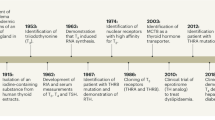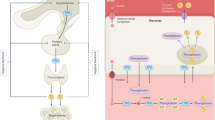Abstract
Thyroid hormone (T3 and T4) has many beneficial effects including enhancing cardiac function, promoting weight loss and reducing serum cholesterol. Excess thyroid hormone is, however, associated with unwanted effects on the heart, bone and skeletal muscle. We therefore need analogs that harness the beneficial effects of thyroid hormone without the untoward effects. Such work is largely based on understanding the cellular mechanisms of thyroid hormone action, specifically the crystal structure of the nuclear receptor proteins. In clinical studies, use of naturally occurring thyroid hormone analogs can suppress TSH levels in patients with thyroid cancer without producing tachycardia. Many thyromimetic compounds have been tested in animal models and shown to increase total body oxygen consumption, and to lower weight and serum cholesterol and triglyceride levels while having minor effects on heart rate. Alternatively, analogs that specifically enhance both systolic and diastolic function are potentially useful in the treatment of chronic congestive heart failure. In addition to analogs that are thyroid hormone receptor agonists, several compounds that are thyroid hormone receptor antagonists have been identified and tested. This Review discusses the potential application of thyroid hormone analogs (both agonists and antagonists) in a variety of human disease states.
Key Points
-
Thyroid hormone receptor agonists and antagonists can be used to harness the beneficial effects of naturally occurring hormones while minimizing adverse effects
-
Knowledge of the crystal structures of the hormone receptors has proved invaluable in designing effective analogs
-
Some analogs can increase total body oxygen consumption, lower weight and improve the lipid profile with only minor effects on heart rate
-
Other analogs can selectively enhance systolic and diastolic function to alleviate congestive heart failure
-
Analogs such as tetraiodothyroacetic acid can affect TSH release from the pituitary
-
Thyroid hormone antagonists might provide an acceptable alternative for conditions such as amiodarone-induced hyperthyroidism
This is a preview of subscription content, access via your institution
Access options
Subscribe to this journal
Receive 12 print issues and online access
$209.00 per year
only $17.42 per issue
Buy this article
- Purchase on Springer Link
- Instant access to full article PDF
Prices may be subject to local taxes which are calculated during checkout



Similar content being viewed by others
References
Edelman IS (1974) Thyroid thermogenesis. N Engl J Med 290: 1303–1308
Oppenheimer JH et al. (1991) Functional relationship of thyroid hormone-induced lipogenesis, lipolysis, and thermogenesis in the rat. J Clin Invest 87: 125–132
Klein I and Ojamaa K (2001) Thyroid hormone and the cardiovascular system. N Engl J Med 344: 501–509
Yen PM (2001) Physiological and molecular basis of thyroid hormone action. Physiol Rev 81: 1097–1142
Ikeda M et al. (1994) Thyroid hormone receptor monomer, homodimer, and heterodimer (with retinoid-X receptor) contact different nucleotide sequences in thyroid hormone response elements. Endocrinology 135: 1628–1638
Hiroi Y et al. (2006) Rapid nongenomic actions of thyroid hormone. Proc Natl Acad Sci USA 103: 14104–14109
Baxter JD et al. (2001) Selective modulation of thyroid hormone receptor action. J Steroid Biochem Mol Biol 76: 31–42
Harrington CR and Barger G (1927) Chemistry of thyroxine. III. Constitution and synthesis of thyroxine. Biochem J 21: 169–183
Gross J and Pitt-Rivers R (1952) The identification of 3:5:3′-L-triiodothyronine in human plasma. Lancet 1: 439–441
Maia AL et al. (2005) Type 2 iodothyronine deiodinase is the major source of plasma T3 in euthyroid humans. J Clin Invest 115: 2524–2533
Koenig R (2005) Regulation of type 1 iodothyronine deiodinase in health and disease. Thyroid 15: 835–840
Cody V (1996) Thyroid hormone structure–function relationships. In Werner and Ingbar´s The Thyroid, edn 7, 185–189 (Eds Braverman LE and Utiger RD) Philadelphia: Lippincott-Raven
Grover GJ et al. (2003) Selective thyroid hormone receptor-β activation: a strategy for reduction of weight, cholesterol, and lipoprotein (a) with reduced cardiovascular liability. Proc Natl Acad Sci USA 100: 10067–10072
Williams GR (2000) Cloning and characterization of two novel thyroid hormone receptor β isoforms. Mol Cell Biol 20: 8329–8342
Lazar MA and Chin WW (1990) Nuclear thyroid hormone receptors. J Clin Invest 86: 1777–1782
Kahaly GJ and Dillmann WH (2005) Thyroid hormone action in the heart. Endocr Rev 26: 708–728
Danzi S and Klein I (2004) Thyroid hormone and the cardiovascular system. Minerva Endocrinologica 29: 139–150
Klein I and Danzi S : Thyroid disease and the heart. Circulation, in press
Hu X and Lazar MA (2000) Transcriptional repression by nuclear hormone receptors. Trends Endocrinol Metab 11: 6–10
Nunes FM et al. (2004) Crystallization and preliminary x-ray diffraction studies of isoform α1 of the human thyroid hormone receptor ligand-binding domain. Acta Crystallogr D Biol Crystallogr 60: 1867–1870
Ribeiro RC et al. (2001) Definition of the surface in the thyroid hormone receptor ligand binding domain for association as homodimers and heterodimers with retinoid X receptor. J Biol Chem 276: 14987–4995
Wagner RL et al. (1995) A structural role for hormone in the thyroid hormone receptor. Nature 378: 690–697
Davis PJ and Davis FB (2002) Nongenomic actions of thyroid hormone on the heart. Thyroid 12: 459–466
Klemperer JD et al. (1995) Thyroid hormone treatment after coronary-artery bypass surgery. N Engl J Med 333: 1522–1527
Morkin E et al. (2002) Pilot studies on the use of 3,5-diiodothyropropionic acid, a thyroid hormone analog, in the treatment of congestive heart failure. Cardiology 97: 218–225
Farwell AP et al. (2006) Dynamic nongenomic actions of thyroid hormone in the developing rat brain. Endocrinology 147: 2567–2574
Webb P (2004) Selective activators of thyroid hormone receptors. Expert Opin Investig Drugs 13: 489–500
Stephan ZF et al. (1992) Reduction of cardiovascular and thyroxine-suppressing activities of L-T3 by liver targeting with cholic acid. Biochem Pharmacol 43: 1969–1974
Leeson PD et al. (1989) Selective thyromimetics. Cardiac-sparing thyroid hormone analogues containing 3′-arylmethyl substituents. J Med Chem 32: 320–336
Chopra IJ et al. (1984) Thyromimetic effects of 3,5-dimethyl,3′-isopropyl thyronine (DIMIT) and 3,5-diethyl,3′-isopropyl thyronine (DIET) in various tissues of the rat. Metabolism 33: 622–628
Barlow JW et al. (1989) The thyroid hormone analogue SKF L-94901: nuclear occupancy and serum binding studies. Clin Sci (Lond) 76: 495–501
Liang H et al. (1997) Organ-specific effects of 3,5,3′-triiodothyroacetic acid in rats. Eur J Endocrinol 137: 537–544
Sherman SI et al. (1997) Augmented hepatic and skeletal thyromimetic effects of tiratricol in comparison with levothyroxine. J Clin Endocrinol Metab 82: 2153–2158
Lameloise N et al. (2001) Differences between the effects of thyroxine and tetraiodothyroacetic acid on TSH suppression and cardiac hypertrophy. Eur J Endocrinol 144: 145–154
Wagner RL et al. (2001) Hormone selectivity in thyroid hormone receptors. Mol Endocrinol 15: 398–410
Baxter JD et al. (2004) Selective activation of thyroid hormone signaling pathways by GC-1: a new approach to controlling cholesterol and body weight. Trends Endocrinol Metab 15: 154–157
Grover GJ et al. (2004) Effects of the thyroid hormone receptor agonist GC-1 on metabolic rate and cholesterol in rats and primates: selective actions relative to 3,5,3′-triiodo-L-thyronine. Endocrinology 145: 1656–1661
Trost SU et al. (2000) The thyroid hormone receptor-β-selective agonist GC-1 differentially affects plasma lipids and cardiac activity. Endocrinology 141: 3057–3064
Ness G et al. (1998) Effects of L-triiodothyronine and the thyromimetic L-94091 on serum lipoprotein levels and hepatic low density lipoprotein receptor, 3-hydroxy-3-methylglutaryl coenzyme A reductase, and apo A-I gene expression. Biochem Pharmacol 56: 121–129
Shin DJ and Osborne TF (2003) Thyroid hormone regulation and cholesterol metabolism are connected through sterol regulatory element-binding protein-2 (SREBP-2). J Biol Chem 278: 34114–34118
Duntas LH (2002) Thyroid disease and lipids. Thyroid 12: 287–293
Drover VA and Agellon LB (2004) Regulation of the human cholesterol 7α-hydroxylase gene (CYP7A1) by thyroid hormone in transgenic mice. Endocrinology 145: 574–581
Johansson L et al. (2005) Selective thyroid receptor modulation by GC-1 reduces serum lipids and stimulates steps of reverse cholesterol transport in euthyroid mice. Proc Natl Acad Sci USA 102: 10297–10302
Klein I (2005) Endocrine disorders and cardiovascular disease. In Braunwald's Heart Disease, edn 7, 2051–2065 (Eds Zipes DP et al.) Philadelphia: Elsevier Saunders
Danzi S and Klein I (2003) Thyroid hormone and blood pressure regulation. Curr Hypertens Rep 5: 513–520
Iervasi G et al. (2003) Low-T3 syndrome: a strong prognostic predictor of death in patients with heart disease. Circulation 107: 708–713
Spooner PH et al. (2004) Thyroid hormone analog, DITPA, improves endothelial nitric oxide and β-adrenergic mediated vasorelaxation after myocardial infarction. J Cardiovasc Pharmacol 44: 453–459
Chang KC et al. (1997) Thyroid hormone improves function and Ca2+ handling in pressure overload hypertrophy. Association with increased sarcoplasmic reticulum Ca2+-ATPase and α-myosin heavy chain in rat hearts. J Clin Invest 100: 1742–1749
Hoit BD et al. (1997) The effects of a thyroid hormone analog on left ventricular performance and contractile and calcium cycling proteins in the baboon. Proc Assoc Am Physicians 109: 136–145
Silva JE and Leonard JL (1985) Regulation of rat cerebrocortical and adenohypophyseal type II 5′-deiodinase by thyroxine, triiodothyronine, and reverse triiodothyronine. Endocrinology 116: 1627–1635
Radetti G et al. (1997) Clinical and hormonal outcome after two years of triiodothyroacetic acid treatment in a child with thyroid hormone resistance. Thyroid 7: 775–778
Jaffiol C et al. (1995) Long term follow up of medical treatment of differentiated thyroid cancer. Ann Endocrinol (Paris) 56: 119–126
Brenta G et al. (2003) Comparative efficacy and side effects of the treatment of euthyroid goiter with levo-thyroxine or triiodothyroacetic acid. J Clin Endocrinol Metab 88: 5287–5292
Baxter JD et al. (2002) Structure-based design and synthesis of a thyroid hormone receptor (TR) antagonist. Endocrinology 143: 517–524
Schapira M et al. (2000) Rational discovery of novel nuclear hormone receptor antagonists. Proc Natl Acad Sci USA 97: 1008–1013
Nguyen NH et al. (2002) Rational design and synthesis of a novel thyroid hormone antagonist that blocks coactivator recruitment. J Med Chem 45: 3310–3320
Moore JMR et al. (2004) Quantitative proteomics of the thyroid hormone receptor-coregulator interactions. J Biol Chem 279: 27584–27590
Basaria S and Cooper DS (2005) Amiodarone and the thyroid. Am J Med 118: 706–714
Silva JE (2003) The thermogenic effect of thyroid hormone and its clinical implications. Ann Intern Med 139: 205–213
Acknowledgements
This work was supported in part by an American Thyroid Association grant to S Danzi and NIH General Clinical Research Center MO1RR018535.
Author information
Authors and Affiliations
Corresponding author
Ethics declarations
Competing interests
I Klein is a Consultant for King Pharmaceuticals, Roche Pharmaceuticals and Titan Pharmaceuticals; he has also received grant support from King Pharmaceuticals. The other authors declared no competing interests.
Rights and permissions
About this article
Cite this article
Brenta, G., Danzi, S. & Klein, I. Potential therapeutic applications of thyroid hormone analogs. Nat Rev Endocrinol 3, 632–640 (2007). https://doi.org/10.1038/ncpendmet0590
Received:
Accepted:
Issue Date:
DOI: https://doi.org/10.1038/ncpendmet0590
This article is cited by
-
A Phase 1b, Open-Label Study to Evaluate the Safety and Tolerability of the Putative Remyelinating Agent, Liothyronine, in Individuals with MS
Neurotherapeutics (2023)
-
Molecular functions and clinical impact of thyroid hormone-triggered autophagy in liver-related diseases
Journal of Biomedical Science (2019)
-
Statin Use and Gastrointestinal Hemorrhage: A Large Retrospective Cohort Study
American Journal of Cardiovascular Drugs (2019)
-
Thyroid hormone misuse and abuse
Endocrine (2019)
-
Thyroid stimulating hormone stimulates the expression of glucose transporter 2 via its receptor in pancreatic β cell line, INS-1 cells
Scientific Reports (2018)



